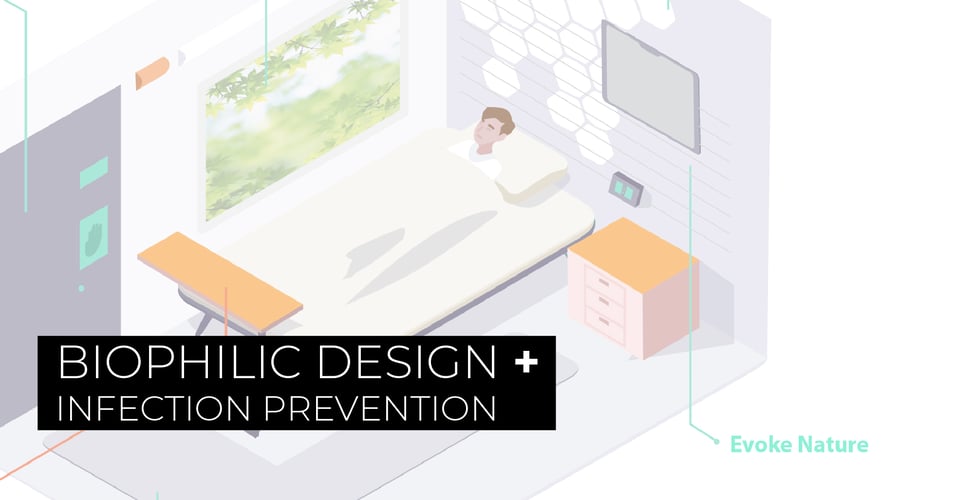How Architecture Standards Align with Infection Control: Part 2

In last week's post, we explored the overlap between architectural principles in the AIA's Framework for Design Excellence. Today, we will look at the foundational components of architectural design and how they overlap with designing with infection control in mind.
Architects approach a project with a foundation of design principles that ensure that the result will satisfy the client, the design aesthetic, and the context of the structure. These principles have expanded over time to include environmental concerns and social impact. And just as the job of infection control includes all staff and departments in a hospital, so does infection control design include every aspect of the architectural process.
1. Meeting individual requirements. Architects work with clients to bring their priorities to life. The most important requirement of a hospital is positive patient outcomes, including the reduction in preventable infections. An architect can help meet these individual requirements by integrating infection control planning from day 1.
2. Aesthetics. Of course, a design must bring beauty into the occupants' life. Hospitals integrate art, natural light, and color in order to surround the patient with a soothing environment. Design choices that do not disrupt this beauty are essential. Infection prevention informed design recommends easy-to-clean shapes for furniture and biocidal materials that do double duty, looking beautiful as well as reducing harmful germs.
3 Social impact. Accessibility, inclusion, and equality are all ideals architects must keep in mind. When it comes to healthcare, a field already struggling with disparities due to race, disability, or socioeconomic status, it is even more important to level the playing field for positive patient outcomes. Reducing preventable infections plays a key role in achieving these ideals, as patients from underserved populations are at greatest risk.
4. Innovation. Innovations in materials, lighting, and structure are some of the most exciting aspects of architecture. Who hasn't felt the awe of a truly innovative space? Innovations that improve patient outcomes may not have the visceral response of a stunning atrium or staircase, but healthcare architects can play a role in positive outcomes with their design choices, especially with infection control. We've already mentioned biocidal materials, but no-splash sinks also help reduce transmission.
5. Context. The architect must recognize the context of their design choices, respecting where the final structure will stand and who it will serve. Even the different occupants of the same structure should be considered. For example, a healthcare architect will design an intensive care unit (ICU) differently than a mental health wing. One of those differences may be the attention to infection control, which in an ICU can mean the difference between life and death.
6. Performance. The final construction must continue to serve the occupants well for years. The materials and structure must hold up to use and still perform at the same levels. If healthcare architects consider infection prevention in their designs, they will select durable materials that do not deteriorate under daily exposure to disinfectants, that are easy to clean, and ideally, can reduce the spread of harmful bacteria.
7. Stewardship of the natural environment. Just as doctors promise to "first, do no harm" to the patient, so the architect must promise to the natural environment. Infection control in hospitals is by its very nature toxic: Disinfectants are used to kill harmful germs that pose a significant danger to vulnerable patients. There are design choices that can mitigate the impact on the environment, however. Ventilation systems can purify air, biocidal materials can kill germs without additional chemicals, and plumbing systems can remove chemicals before releasing waste into the water system. Copper, a natural biocidal material, poses no threat to the environment or users, making it an ideal surface for healthcare.
Ideally, infection control will become a foundational principal of its own for all future healthcare projects. Until that day, architects have numerous design choices at hand which can help their clients save lives by preventing hospital-associated infections. There are positive health outcomes - both medical and financial - at the intersection of form, function, and beauty.
![EOScu Logo - Dark - Outlined [07182023]-01](https://blog.eoscu.com/hubfs/Eoscu_June2024/Images/EOScu%20Logo%20-%20Dark%20-%20Outlined%20%5B07182023%5D-01.svg)

![[infographic] Elements of Evidence-Based Design Download and share!](https://no-cache.hubspot.com/cta/default/216314/interactive-178541431627.png)



